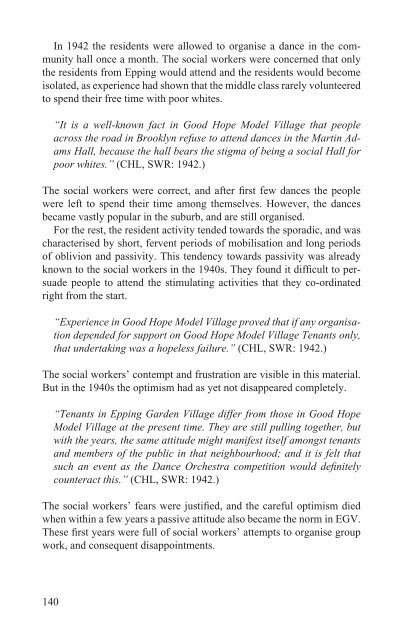The Making of a Good White - E-thesis - Helsinki.fi
The Making of a Good White - E-thesis - Helsinki.fi
The Making of a Good White - E-thesis - Helsinki.fi
You also want an ePaper? Increase the reach of your titles
YUMPU automatically turns print PDFs into web optimized ePapers that Google loves.
In 1942 the residents were allowed to organise a dance in the community<br />
hall once a month. <strong>The</strong> social workers were concerned that only<br />
the residents from Epping would attend and the residents would become<br />
isolated, as experience had shown that the middle class rarely volunteered<br />
to spend their free time with poor whites.<br />
“It is a well-known fact in <strong>Good</strong> Hope Model Village that people<br />
across the road in Brooklyn refuse to attend dances in the Martin Adams<br />
Hall, because the hall bears the stigma <strong>of</strong> being a social Hall for<br />
poor whites.” (CHL, SWR: 1942.)<br />
<strong>The</strong> social workers were correct, and after <strong>fi</strong>rst few dances the people<br />
were left to spend their time among themselves. However, the dances<br />
became vastly popular in the suburb, and are still organised.<br />
For the rest, the resident activity tended towards the sporadic, and was<br />
characterised by short, fervent periods <strong>of</strong> mobilisation and long periods<br />
<strong>of</strong> oblivion and passivity. This tendency towards passivity was already<br />
known to the social workers in the 1940s. <strong>The</strong>y found it dif<strong>fi</strong>cult to persuade<br />
people to attend the stimulating activities that they co-ordinated<br />
right from the start.<br />
“Experience in <strong>Good</strong> Hope Model Village proved that if any organisation<br />
depended for support on <strong>Good</strong> Hope Model Village Tenants only,<br />
that undertaking was a hopeless failure.” (CHL, SWR: 1942.)<br />
<strong>The</strong> social workers’ contempt and frustration are visible in this material.<br />
But in the 1940s the optimism had as yet not disappeared completely.<br />
“Tenants in Epping Garden Village differ from those in <strong>Good</strong> Hope<br />
Model Village at the present time. <strong>The</strong>y are still pulling together, but<br />
with the years, the same attitude might manifest itself amongst tenants<br />
and members <strong>of</strong> the public in that neighbourhood; and it is felt that<br />
such an event as the Dance Orchestra competition would de<strong>fi</strong> nitely<br />
counteract this.” (CHL, SWR: 1942.)<br />
<strong>The</strong> social workers’ fears were justi<strong>fi</strong>ed, and the careful optimism died<br />
when within a few years a passive attitude also became the norm in EGV.<br />
<strong>The</strong>se <strong>fi</strong>rst years were full <strong>of</strong> social workers’ attempts to organise group<br />
work, and consequent disappointments.<br />
140
















